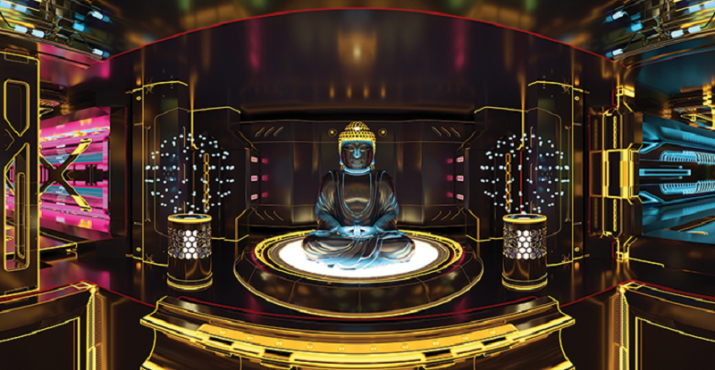
This Mindful Technology column started with the aim of exploring and deepening the relationship between the various aspects of technology and mindfulness. Correlating the Noble Eightfold Path and engineering development has highlighted interesting parallels, and to some extent demonstrated how the two disciplines can strengthen each other.
Now the focus of the column is shifting to capture some of the advances in cognitive engineering, and the relevance and importance of Buddhist teachings to technology development. There is a lot going on in relation to mind technologies.
My previous article references a few examples of experiments in brain–machine communication, which in many ways represents the next frontier of IT. More recently, a technique called Brain Net developed by the University of Washington, described as a multi-person non-invasive direct brain-to-brain interface for collaborative problem solving, combines electroencephalography (EEG) to record brain signals and transcranial magnetic stimulation (TMS) to deliver information noninvasively to the brain allowing three human subjects to collaborate and solve a task using direct brain-to-brain communication.* The implications of this new frontier are vast.
The International Conference on Awareness Science and Technology (iCAST) is a conference endorsed by the Institute of Electrical and Electronics Engineers (IEEE) where research on awareness science and technology and on perceptual psychology converge. The 2018 edition of the conference was held last September in Fukuoka, Japan. Participants of the conference, mostly from Asian countries and familiar with Buddhist thought, showed great interest in the idea that the Noble Eightfold Path could help guide technology development, as discussed in this column.
According to the Merriam-Webster Dictionary, “awareness” can be referred to as “the quality or state of being aware, having knowledge and understanding that something is happening or exists.” In humans, awareness generally develops through the five senses as well as some high-level cognition and intuition, sometimes referred to as the sixth sense, which is not yet well understood by modern science.
In Buddhist thought, “awareness” is closely correlated to attention (were we focus our thoughts and senses), and ultimate awareness coincides with a certain level of spiritual attainment or enlightenment. Meditation, as a type of awareness practice, leads to chit (चित्) which in Sanskrit means awareness or consciousness. In technology and computer science, “awareness” can point to awareness of a system’s internal state or status of some component or function, referred to as computing self awareness. Other examples of awareness in computing include context awareness, situational awareness, and algorithmic awareness.
The science and technology of awareness is perhaps the closest to the interdisciplinary research field of consciousness studies. Throughout the history of computing, a few researchers have laid claim to developing artificial consciousness, but none have been able to stand the test of time. These days, scientists claim to be able to develop some degree of systems awareness, at most.
The scope of my own work in awareness research seeks to improve human understanding of awareness science through the study of root teachings and the application of principles from ancient wisdom traditions, such as Buddhism. By attempting to make these principles explicit and facilitate their encoding in novel technology development methods and techniques, these ancient paradigms can be applied to system development with the intent of creating machines capable of ethically sound reasoning and optimal decision making.
UK-based researcher and lecturer Peter Lewis gave an inspiring address at iCAST2018, advocating for self-aware computers in order to address the complexities that may lead to computer behaviors that are difficult to understand, predict, and control. Increased self-awareness could help to enable more advanced autonomous adaptive behavior in computers.
Western thought on self-awareness comes mostly from psycho-analysis. Freud, for example, theorized three levels of awareness: the conscious, the preconscious, and the unconscious,** and Carl Jung also discussed self-awareness.*** In cognitive neuroscience, awareness is described as “a pivotal component of conscious experience . . . correlated with a paralimbic network of medial prefrontal/anterior cingulate and medial parietal/posterior cingulate cortical ‘hubs’ and associated regions.” (Lou, Changeux, and Rosenstand, 2017)
In computer science, research has so far concentrated mostly on awareness delivered by physical sensing.**** Physical awareness is constrained by the limitations of the senses, and while human senses are very sophisticated they are far from perfect. Sensorial perception can be deceiving because it does not allow for “pure perception.” It is not easy to explain the notion of pure perception to technologists because understanding implies the acceptance of a worldview that is very distant from what is considered an acceptable, ordinary view.
Yet, even at a basic level, it can be said that signals, if not accurate, clear, and unambiguous, can be confusing and misleading, and that perception filters and can distort reality (as in the case of conditions such as color blindness, for example). Even those unaware of the ancient wisdom traditions have no problem accepting that sensorial perception does not capture or represent what is behind physical reality. And from a mind-science perspective, the self (apparently) does not even exist other than as a temporal set of coincidental aggregates, but that would take some time to explain.
This is the essence of my contribution to awareness research, largely based on reflections contained in this column: advanced computing needs knowledge from the wisdom traditions.
* BrainNet: A Multi-Person Brain-to-Brain Interface for Direct Collaboration Between Brains (Cornell University Library)
** 3 Levels of awareness (Freud: History and Concepts)
*** Carl Jung on his first surprising moment of self-awareness
**** Filip Maertens – Artificial Intelligence: Building Emotion & Context aware Real-time Applications (SlideShare)
References
Lou, H. C., J. P. Changeux, and A. Rosenstand. 2017. “Towards a cognitive neuroscience of self-awareness” In Neuroscience & Biobehavioral Reviews. 83: 765–73. (Link)














